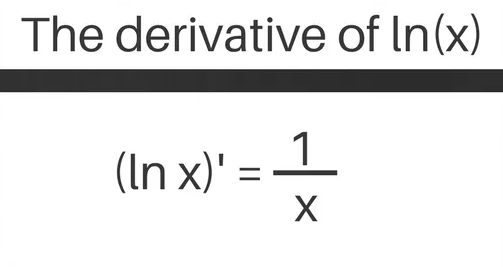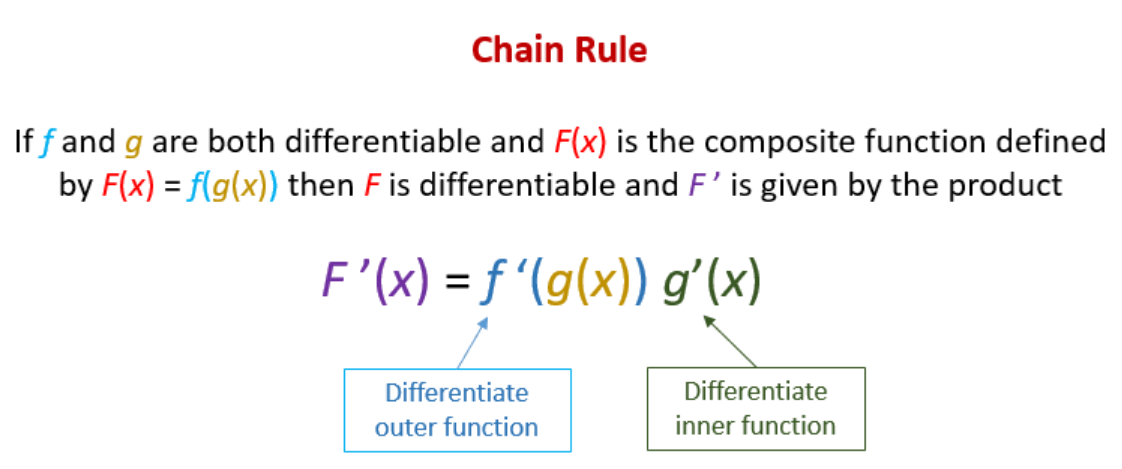Table of Contents
The derivative of ln x – Part of calculus is memorizing the basic derivative rules like the product rule, the power rule, or the chain rule. One of the rules you will see come up often is the rule for the derivative of ln x. In the following lesson, we will look at some examples of how to apply this rule to finding different types of derivatives. We will also see how using the laws of logarithms can help make taking these kinds of derivatives even easier.
Let’s look at our first method, the chain rule. How does the chain rule work? Well, first of all, the chain rule is a formula for figuring out the composition of two or more functions. Let’s say we have a function with a complicated argument, like sin x2. The function is sine and the argument is x2. If the argument were simply x, we’d differentiate sin x and get cos x.
Derivative Of ln x
The derivative of ln(x) is a well-known derivative. This lesson will show us the steps involved in finding this derivative, and it will go over a real-world application that involves the derivative of ln(x).

Derivative Of Ln(x) Steps to Solve
We want to find the derivative of ln(x). The derivative of ln(x) is 1/x and is actually a well-known derivative that most put to memory. However, it’s always useful to know where this formula comes from, so let’s take a look at the steps to actually find this derivative.
To find the derivative of ln(x), the first thing we do is let y = ln(x). Next, we use the definition of a logarithm to write y = ln(x) in logarithmic form. The definition of logarithms states that y = log b (x) is equivalent to b y = x. Therefore, by the definition of logarithms and the fact that ln(x) is a logarithm with base e, we have that y = ln(x) is equivalent to e^y = x.
y=ln(x) is equivalent to e^y=x
Okay, just a few more steps, and we’ll have our formula! The next thing we want to do is treat y as a function of x, and take the derivative of each side of the equation with respect to x. We use the chain rule on the left-hand side of the equation to find the derivative. The chain rule is a rule we use to take the derivative of a composition of functions, and it has two forms.

The left hand side of the equation is e ^y, where y is a function of x, so if we let f(x) = e ^x and g(x) = y, then f(g(x)) = e ^y. Since the derivative of e to a variable (such as e ^x) is the same as the original, the derivative of f'(g(x)) is e ^y. Therefore, by the chain rule, the derivative of e y is e^y dy/dx. On the right-hand side we have the derivative of x, which is 1.
We have (e ^y) dy/dx = 1. Now, recall that e y = x. We’re going to use this fact to plug x into our equation for e y.

This gives us the equation (x)dy/dx = 1. We’re getting super close now! Are you as excited as I am? We can divide both sides of this equation by x to get dy/dx = 1/x. The last thing is to recall that y = ln(x) and plug this into our equation for y.We have (e^ y) dy/dx = 1. Now, recall that e ^y = x. We’re going to use this fact to plug x into our equation for e y.

Ta-da! Now, we see that d/dx ln(x) = 1/x, and now we know why this formula for the derivative of ln(x) is true. So what’s our solution? The derivative of ln(x) is 1 / x.
Derivative Of Ln(x) Summary
Remember the following points when finding the derivative of ln(x):
- The derivative of ln(x)ln(x) is 1x1x.
- In certain situations, you can apply the laws of logarithms to the function first and then take the derivative.
- Values like ln(5)ln(5) and ln(2)ln(2) are constants; their derivatives are zero.
- ln(x+y)ln(x+y) DOES NOT EQUAL ln(x)+ln(y)ln(x)+ln(y); for a function with addition inside the natural log, you need the chain rule.
- ln(x–y)ln(x–y) DOES NOT EQUAL ln(x)–ln(y)ln(x)–ln(y); for a function with subtraction inside the natural log, you need the chain rule.
Derivative Of lnx^2
The Steps to Calculate
Let’s look at our first method, the chain rule. How does the chain rule work? Well, first of all, the chain rule is a formula for figuring out the composition of two or more functions. Let’s say we have a function with a complicated argument, like sin x2. The function is sine and the argument is x2. If the argument were simply x, we’d differentiate sin x and get cos x.
To use the chain rule, we imagine the function has a simple argument and we write the derivative. In this example, the derivative of sin x2 is cos x2. And then, we multiply by the derivative of the argument. The derivative of x2 is 2x. Thus, using the chain rule, the derivative of sin x2 is cos x2 times 2x or just 2x cos x2.
Step 1: Differentiate with the Chain Rule
The derivative of ln x is 1/x, so the derivative of ln x2 is 1/x2 times the derivative of x2:
Step 2: SimplifyThen, the derivative of x2 is 2x:
1/x2 times 2x can be written as 2x/x2.
Canceling the common x term:
Step 1: Rewrite ln x2 Using Logarithm Properties
Now, let’s look at our second method, the properties of logarithms, which are basically the properties or characteristics of exponents.
The logarithm of x to a power n equals n times the logarithm of x. Thus, ln x2 = 2 ln x.
Step 2: Differentiate
Leaving us with the derivative of ln x, which is 1/x The constant 2 comes out of the differentiation:
The 2 multiplied by 1/x is written as 2/x:
Step 3: Simplify
Thus, the derivative of ln x2 is 2/x. Note this result agrees with the plots of tangent lines for both positive and negative x. For x = 2, the derivative is 2/2 = 1, which agrees with the plot. And for x = -2, the derivative is 2/(-2) = -1, which agrees with the negative sloping tangent line at x = -2.
Antiderivative Of ln x
∫lnxdx=xlnx−x+C
Explanation:
The integral (antiderivative) of lnx is an interesting one because the process to find it is not what you’d expect.
We will be using integration by parts to find ∫lnxdx:
∫udv=uv−∫vdu
Where u and v are functions of x.
Here, we let:
u=lnx→dudx=1x→du=1xdx and dv=dx→∫dv=∫dx→v=x
Making necessary substitutions into the integration by parts formula, we have:
∫lnxdx=(lnx)(x)−∫(x)(1xdx)
→(lnx)(x)−∫x(1xdx)
=xlnx−∫1dx
=xlnx−x+C→ (don’t forget the constant of integration!)
Derivative Of 1/lnx
=−1x(lnx)2
Explanation:
you can do this simply as ((lnx)−1)‘
=−(lnx)−2(lnx)‘
=−(lnx)−21x
=−1x(lnx)2
if you want to fiddle about with e and logs i suppose you could say that
1y=lnx
e1y=elnx=x
so
(e1y)‘=1
and
(e1y)‘=e1y(1y)‘
=e1y⋅−(1y2)y‘
So −e1y(1y2)y‘=1
y‘=−y2⋅1e1y
=−(1lnx)2⋅1x
=−1x(lnx)2
same but bit more involved and fiddly
Derivative Of (lnx)^2
dydx=2x
Explanation:
Applying the chain rule, along with the derivatives d/dx ln(x)=1x and ddxx2=2x, we have
dydx=ddxln(x2)
=1x2(ddxx2)
=1x2(2x)
=2x
Derivative Of lnx 3
I got y‘=3x
Explanation:
We can use one of the properties of logs that allow us to write it as:
y=3ln(x)
We can then derive as usual:
y‘=3⋅1x
We can also use the Chain Rule deriving the log first as it is and multiply by the derivative of the argument:
y‘=1x3⋅3x2= simplify:
=3x
